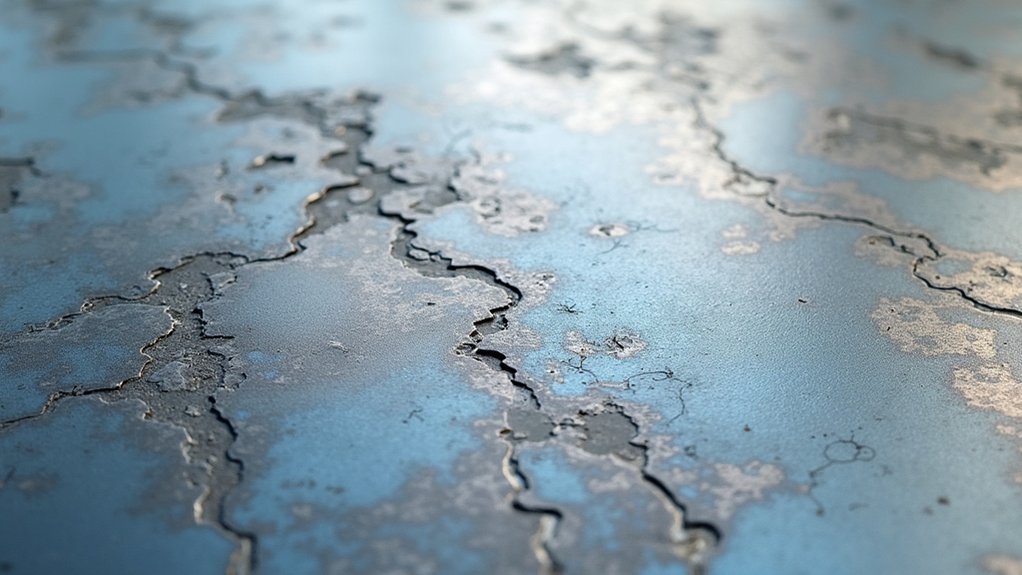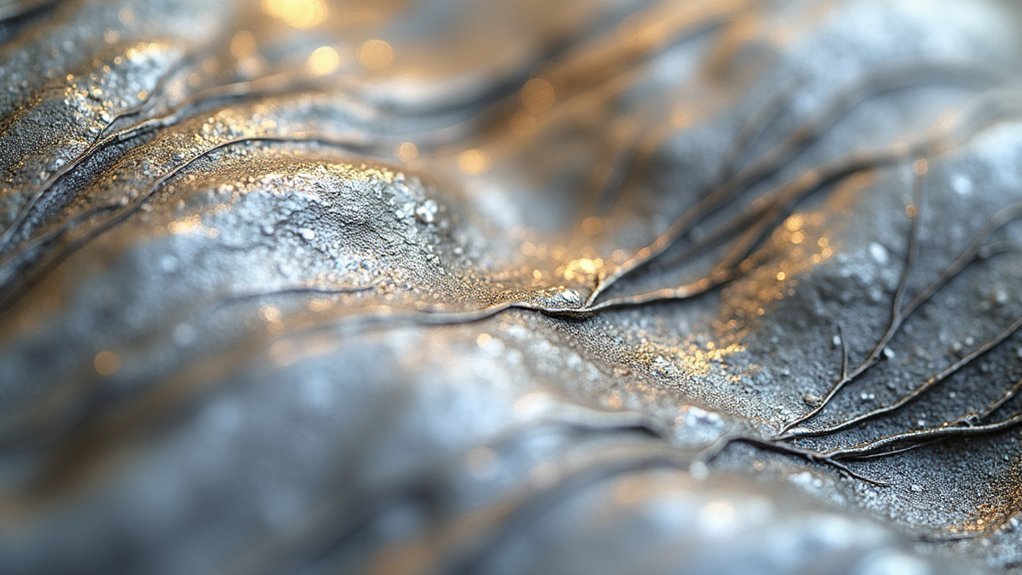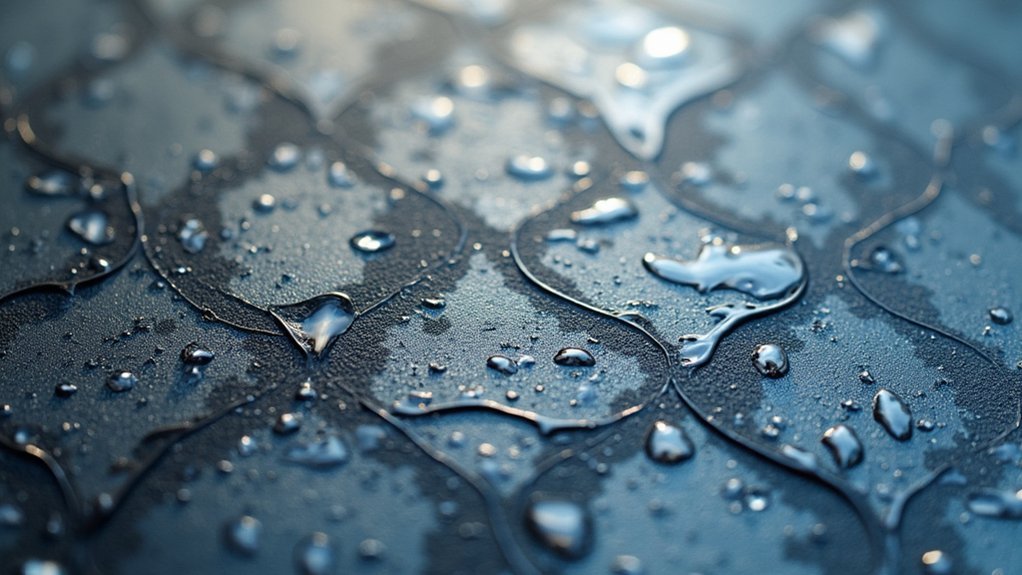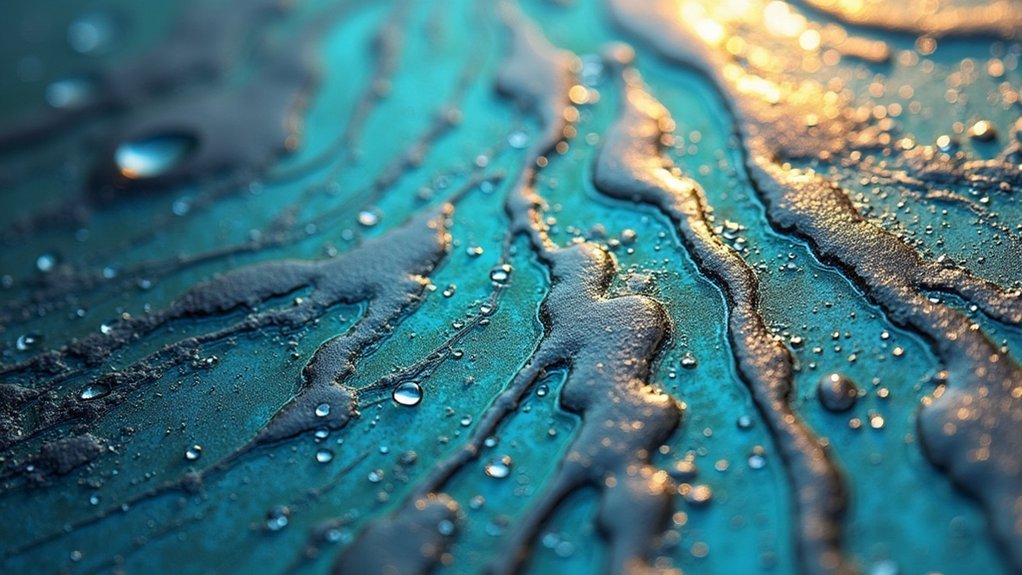Platinum develops beautiful patina through controlled oxidation when it reacts with oxygen and moisture in your environment. Your skin’s natural oils and acids interact with the metal’s surface, creating unique patterns based on your individual pH levels and body chemistry. Environmental factors like humidity, temperature fluctuations, and pollution exposure accelerate this process, while daily wear generates micro-scratches that enhance the patina’s intricate appearance. Continue exploring to discover specific preservation techniques that’ll maintain your platinum’s distinctive character.
Understanding the Science Behind Platinum Patina Formation

When platinum jewelry encounters oxygen and moisture in everyday environments, it undergoes a fascinating chemical transformation that creates its signature patina.
Platinum’s natural reaction with oxygen and moisture transforms your jewelry into a uniquely beautiful piece with its own distinctive character.
This oxidation process develops naturally as your platinum pieces react with environmental factors like humidity and temperature fluctuations. Your body chemistry plays an essential role too—natural oils and acids from your skin influence how the patina formation progresses.
As you wear your platinum jewelry daily, micro-scratches accumulate on the surface. Unlike other metals where material is lost, platinum simply displaces, contributing to the patina’s development.
These environmental factors and physical wear combine to create unique patterns with distinctive colors ranging from subtle grays to blues and pink undertones, making each piece’s patina as individual as your personal experiences.
Environmental Factors That Influence Patina Development
Since your platinum jewelry lives in constant contact with the surrounding environment, specific atmospheric conditions greatly shape how its patina develops. Humidity levels accelerate the oxidation process, with moisture-rich air speeding transformation. Exposure to sulfur compounds in urban and coastal areas enhances patina formation rates considerably.
| Environmental Factor | Impact on Patina |
|---|---|
| High Humidity | Accelerates oxidation process |
| Sulfur Compounds | Enhances formation rates |
| Temperature Fluctuations | Affects oxidation speed |
Your wearer’s body chemistry creates personalized patina patterns through natural oils and acids. Environmental conditions like extreme temperatures alter how quickly oxidation occurs on platinum surfaces. Urban environments with pollution and coastal areas with salt air particularly influence patina development, creating unique finishes that reflect your jewelry’s exposure history.
The Role of Body Chemistry in Creating Unique Patina Patterns

Your body chemistry plays an essential role in how your platinum jewelry develops its distinctive patina patterns.
The natural oils and acids from your skin interact with the metal’s surface, creating unique formations that reflect your individual pH levels and sweat composition.
As you wear your platinum pieces regularly, these personal chemical interactions combine with your lifestyle habits to produce a completely one-of-a-kind appearance that can’t be replicated by anyone else.
Personal Chemistry Affects Patina
Although platinum may seem like an inert metal, your body’s unique chemistry actively shapes how patina develops on your jewelry. Your skin’s natural oils, sweat, and pH levels create distinct patterns that make each piece truly yours.
Individual differences in skin acidity produce varying results. Some people develop soft gray tones, while others create warmer hues through their body chemistry. The oxidation process accelerates when sulfur compounds in the air interact with your skin’s chemistry, forming distinctive patterns over time.
| Chemistry Factor | Effect on Patina | Result |
|---|---|---|
| Low skin pH | Faster patina development | Deeper color tones |
| High skin pH | Slower oxidation process | Lighter gray shades |
| Diet changes | Altered body chemistry | Shifting patina colors |
| Stress levels | Increased perspiration | Accelerated pattern formation |
| Health conditions | Modified skin composition | Unique patina characteristics |
Your personalized patina reflects your lifestyle, creating a unique patina that’s unmistakably yours.
Skin Oils Create Patterns
When you wear platinum jewelry regularly, your skin’s natural oils create intricate microscopic patterns across the metal’s surface. Your body chemistry produces a unique blend of oils and acids that interact differently with platinum, resulting in patina formation that’s distinctly yours.
These skin oils don’t simply coat the metal—they chemically bond with it, creating aesthetic appeal through personalized patterns. The frequency of wear accelerates this process, as consistent contact allows your natural oils to build up gradually:
- Your individual oil composition determines the specific pattern characteristics and distribution
- Environmental humidity affects how quickly your skin oils penetrate and react with the platinum
- The accumulated oils form a protective layer that enhances both durability and visual depth
This creates unique patterns that reflect your personal body chemistry.
Individual Wear Influences Formation
Beyond the basic interaction of oils with platinum, each person’s unique body chemistry acts as a master craftsman, sculpting distinctive patina patterns that can’t be replicated.
Your individual body chemistry determines how your natural oils interact with the metal, while environmental factors like humidity and temperature vary between wearers, influencing patina formation rates.
Frequent wear accelerates this development as your jewelry moves against skin, creating micro-scratches that enhance the patina’s texture.
Your personal habits matter too – lotions, perfumes, and chemical exposure from your lifestyle create distinct looks.
The result? Your platinum jewelry develops a one-of-a-kind patina reflecting your unique experiences and daily interactions with the metal, making each piece truly yours.
How Moisture and Humidity Accelerate the Oxidation Process

When you wear platinum jewelry in humid conditions, you’re accelerating the oxidation process that creates its distinctive patina.
Moisture in the air provides the perfect catalyst for platinum to react with oxygen, while high humidity levels speed up this natural transformation considerably.
You’ll notice this effect is particularly pronounced if you live in coastal areas or frequently expose your jewelry to moisture-rich environments.
Humidity’s Oxidation Effects
As moisture levels rise in your environment, platinum’s patina development accelerates dramatically through enhanced oxidation processes.
The humidity creates ideal conditions for atmospheric elements to interact with your platinum jewelry’s surface, forming that coveted oxidized layer much faster than in dry climates.
Your platinum piece will develop noticeable patina within months in humid environments, while the same formation might take years in arid conditions.
The moisture acts as a catalyst, enabling chemical reactions that create the characteristic surface changes you’ll observe.
- Sulfur compounds in humid air enhance patina formation, adding unique colors and distinctive tones to your platinum’s surface
- Regular humid exposure creates more pronounced, intricate patina patterns reflecting your lifestyle
- Higher humidity levels directly correlate with faster oxidation rates and more complex patina development
Moisture Exposure Impact
Moisture acts as a powerful accelerator in platinum’s patina formation, transforming what could be a decades-long process into something you’ll notice within months of regular wear.
When you expose your platinum jewelry to moisture exposure, the oxidation process intensifies dramatically. Water molecules interact directly with platinum’s surface, creating an ideal environment for oxide layer formation that produces that coveted lustrous sheen.
Your body chemistry plays a vital role during this transformation. Natural oils and acids from your skin combine with ambient moisture, creating unique patina development patterns specific to your wear habits.
In humid environments, sulfur compounds further accelerate these changes. The continuous cycle of moisture contact and evaporation gradually builds the patina’s depth and character.
Environmental Acceleration Factors
Beyond your personal wear patterns, specific environmental conditions greatly speed up platinum’s patina development through measurable atmospheric factors.
Higher humidity levels greatly accelerate the oxidation process by increasing atmospheric moisture that interacts with your jewelry’s surface. Your body chemistry contributes uniquely through natural oils and sweat that combine with environmental moisture, creating distinctive patina formation patterns.
Temperature fluctuations enhance oxidation rates, with warmer conditions promoting faster development. Coastal environments present additional acceleration factors through sulfur compounds that hasten the patina process.
Key environmental accelerators include:
- Coastal proximity – Salt air and sulfur compounds create reactive conditions
- Temperature variation – Heat cycles that expand oxidation activity
- Sustained humidity exposure – Consistent moisture leading to richer, pronounced patina
Regular exposure to these humid conditions produces the most aesthetically appealing results.
Temperature Variations and Their Impact on Patina Formation

Temperature swings play an important role in how quickly your platinum jewelry develops its coveted patina.
Temperature variations directly affect the rate of patina formation, with warmer conditions accelerating the oxidation process through increased exposure to moisture and oxygen. You’ll notice faster patina development in humid climates, while cooler environments slow oxidation, creating more gradual changes.
Warmer temperatures and humidity accelerate platinum’s patina development, while cooler conditions create slower, more gradual oxidation patterns.
These fluctuating temperatures create unique patina patterns across your jewelry’s surface.
Different areas oxidize at varying speeds based on their heat exposure, producing distinctive color variations and depth. Through regular wear in diverse temperature conditions, you’re fundamentally helping your platinum develop richer, more complex patina characteristics.
Each temperature change contributes to the overall beauty and uniqueness of your piece’s evolving surface.
The Timeline of Natural Patina Development in Platinum Jewelry
You’ll notice the first signs of patina appearing as subtle micro-scratches and a gentle dulling of your platinum’s mirror-like finish within just a few months of regular wear.
Environmental factors like humidity and air pollutants can greatly speed up this natural aging process, while your body’s unique chemistry creates distinctive patterns that won’t match anyone else’s jewelry.
What starts as barely perceptible changes gradually transforms into platinum’s signature soft, matte appearance over several years of faithful wear.
Early Patina Signs
When you first slip on a new platinum ring or necklace, the metal’s mirror-like finish appears flawless, but this pristine surface won’t last forever.
The early signs of patina begin appearing within months as micro-scratches accumulate from your daily activities. The development of patina depends heavily on your body chemistry and environmental conditions around you.
You’ll notice the first changes between six months to a year:
- Areas experiencing frequent friction, like your ring’s underside, show patina signs first
- Humid environments accelerate the formation process greatly
- The surface gradually shifts from brilliant shine to a soft matte appearance
This natural evolution creates a unique character that’s entirely yours, reflecting how you interact with your jewelry through everyday wear and personal habits.
Accelerating Development Factors
Several environmental and personal factors dramatically speed up platinum’s patina development, transforming what might be a years-long process into one that unfolds within mere months.
Your jewelry’s exposure to sulfur compounds and higher humidity levels creates ideal conditions for accelerated patina formation. Wear frequency plays an essential role—daily use generates micro-scratches that enhance the matte finish development. Your body chemistry contributes considerably, as natural skin oils and acids interact with platinum to create unique patina patterns.
| Factor | Impact Level | Timeline Effect |
|---|---|---|
| High humidity + sulfur compounds | Severe | Months vs. years |
| Daily wear frequency | Moderate | 6-12 months faster |
| Coastal/polluted environments | High | 3x acceleration |
| Individual body chemistry | Variable | Unique patterns |
Environmental conditions in coastal or high-pollution areas further accelerate this beautiful transformation process.
Long-Term Transformation Process
While platinum’s initial patina changes emerge within weeks of regular wear, the complete transformation unfolds as a fascinating multi-year journey that reflects your jewelry’s unique story.
This natural process creates distinctive character through accumulated micro-scratches and chemical interactions with your body chemistry. Your platinum’s long-term transformation develops gradually, with environmental exposure to elements like humidity and sulfur compounds influencing the timeline.
Each piece evolves its own signature appearance through:
- Color variations ranging from soft gray tones to warm golden hues
- Texture changes from smooth surfaces to subtly matte finishes
- Individual patterns reflecting your specific lifestyle and wearing habits
The patina development becomes more pronounced over several years, creating a unique patina that tells your personal story while maintaining platinum’s inherent durability and precious metal value.
Differences Between Platinum Patina and Other Metal Oxidation
Understanding how platinum’s patina differs from other metal oxidation reveals why this precious metal is so prized for jewelry and luxury items.
When you wear platinum jewelry, its surface develops a controlled oxidation layer through micro-scratching that creates an elegant, matte finish with subtle sheen. Unlike gold, which loses microscopic metal when scratched, platinum displaces material to form character-rich patina that enhances durability.
You’ll notice silver develops unwanted tarnish requiring removal, while copper and brass show dramatic color changes from uncontrolled corrosion.
Platinum’s patina formation responds differently to environmental factors like humidity and body chemistry, producing muted colors rather than the pronounced discoloration you’d see with silver. This controlled process makes platinum’s aging desirable rather than problematic.
Why Platinum Patina Enhances Rather Than Diminishes Beauty

Platinum’s patina transforms what many consider “aging” into a coveted enhancement that amplifies the metal’s inherent beauty.
Unlike other metals that deteriorate, platinum’s natural patina enhances each piece with remarkable depth and character that can’t be replicated artificially.
The patina development creates stunning visual benefits:
- Subtle color variations – Gray, blue, and pink hues emerge, reflecting your unique wearing patterns
- Enhanced craftsmanship visibility – Fine details become more pronounced through the matte finish
- Increased sentimental value – Each scratch tells your personal story
This transformation showcases platinum’s superior durability while adding authentic vintage appeal.
The patina’s controlled development guarantees your jewelry maintains its beauty indefinitely, evolving gracefully rather than degrading.
You’re witnessing precious metal at its finest—where time enhances rather than diminishes value.
The Unique Color Variations in Platinum Patina
As your platinum jewelry ages, it develops a mesmerizing spectrum of colors that transforms its appearance into something truly extraordinary.
The unique color variations in platinum patina range from soft grays to warm golden hues and subtle blue undertones. This oxidation process occurs when your jewelry reacts with oxygen and atmospheric elements, actually enhancing its aesthetic appeal rather than diminishing it.
Environmental factors like humidity, temperature, and air exposure influence these stunning transformations. Your body chemistry also plays a role, ensuring each piece develops a completely personalized appearance that reflects your lifestyle and experiences.
Unlike other metals that simply tarnish, platinum’s patina creates a rich visual tapestry that tells your jewelry’s unique story, making every piece distinctively yours.
Daily Wear Patterns That Contribute to Patina Formation
Every touch, grasp, and gesture you make while wearing platinum jewelry contributes to its evolving patina through distinctive wear patterns that create a personalized finish.
Your daily wear habits directly influence patina formation, as regular contact with surfaces creates micro-scratches that gradually refine the metal’s appearance. When you wear platinum frequently, these patterns develop faster and more distinctly.
Your body chemistry accelerates this transformation through natural oils and acids that interact with the metal’s surface. Environmental factors like humidity and pollutants further enhance the process during daily activities.
- Ring bottoms develop patina faster than shoulders due to constant contact with surfaces
- Bracelet links show varied wear based on your hand movements and grip patterns
- Necklace clasps patina differently from pendants due to handling frequency
These unique characteristics guarantee your platinum jewelry becomes truly one-of-a-kind.
Chemical Reactions That Create Platinum’s Distinctive Finish
Behind platinum’s coveted patina lies a fascinating controlled oxidation process that transforms the metal’s surface through chemical interactions with oxygen and environmental elements.
Unlike rapid corrosion, this gradual transformation creates a thin protective layer that enhances platinum’s natural beauty.
Your wearer’s body chemistry plays an essential role in these chemical reactions. Natural oils, acids, and pH levels from your skin interact with the platinum surface, creating unique patterns and color variations.
Your skin’s unique chemistry creates personalized patina patterns, making each piece of platinum jewelry as individual as you are.
Environmental factors like humidity and temperature accelerate or slow these processes.
The distinctive finish emerges as platinum molecules bond with oxygen, forming subtle gray tones with occasional blue or pink undertones.
This patina isn’t damage—it’s a desirable transformation that makes your jewelry uniquely yours through personalized chemical interactions.
Preservation Methods for Maintaining Desired Patina Effects
When you’ve achieved platinum’s perfect patina, strategic preservation becomes essential for maintaining that distinctive appearance you’ve grown to love.
Preserving the patina requires thoughtful care that protects while allowing natural character to shine through. Your proper care routine should focus on gentle cleaning solutions rather than harsh chemicals that strip away the oxidation layer.
Store pieces separately to prevent friction damage, and consider professional cleaning when you need expert assessment of your jewelry’s condition.
Key preservation strategies include:
- Using mild, non-abrasive soap with soft brushes for regular maintenance
- Avoiding ultrasonic cleaners and chemical treatments that damage patina integrity
- Controlling humidity exposure to manage how patina develops over time
You’ll find that consistent, gentle care preserves your platinum’s unique character while maintaining its lustrous beauty.
Frequently Asked Questions
What Causes Platinum to Patina?
Your platinum develops patina through micro-scratches from daily wear, exposure to your body’s natural oils and acids, plus environmental factors like humidity and oxygen that create unique gray, blue, and pink patterns.
What Is the Patina Effect on Platinum?
You’ll notice platinum’s patina effect creates a soft, satiny finish through micro-scratches from daily wear. It doesn’t compromise durability but adds unique character, depth, and muted tones that make your jewelry distinctly beautiful.
Is Platinum Patina Good?
Yes, platinum patina’s excellent for you. It adds character, authenticity, and vintage appeal to your jewelry without compromising durability. You’ll find it enhances beauty while representing your piece’s unique journey and experiences over time.
Does Platinum Age Well?
You’ll find platinum ages exceptionally well, developing a beautiful patina that enhances its character over time. It won’t tarnish or corrode, maintaining structural integrity while creating a distinctive, soft matte finish that’s uniquely yours.
In Summary
You’ve now discovered that platinum’s beautiful patina isn’t just random tarnishing—it’s a complex dance between science and daily life. Your body chemistry, the environments you frequent, and how you wear your platinum pieces all contribute to creating a finish that’s uniquely yours. By understanding these factors, you can either embrace the natural aging process or take steps to preserve your platinum’s original luster for years to come.





Leave a Reply